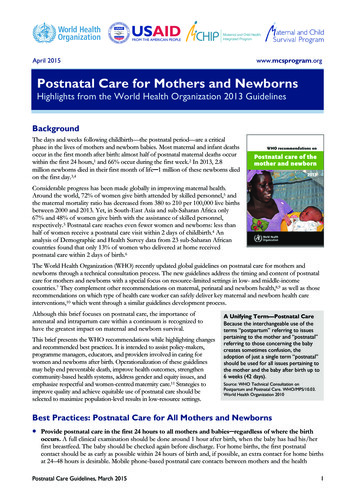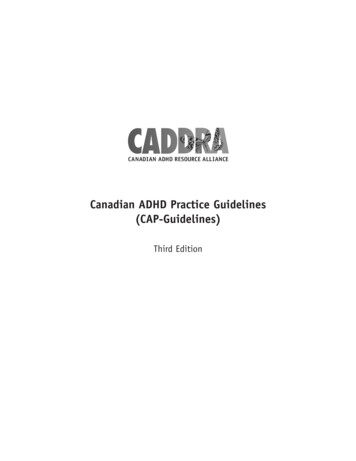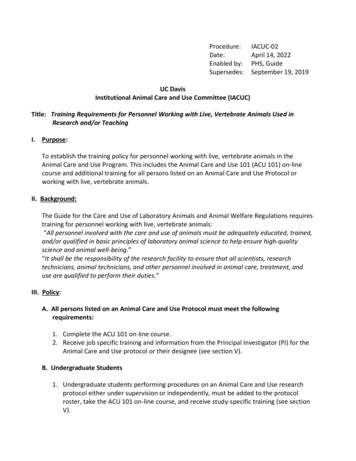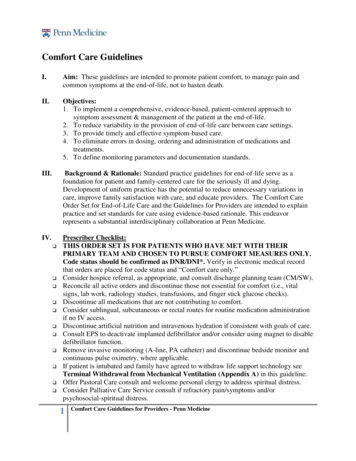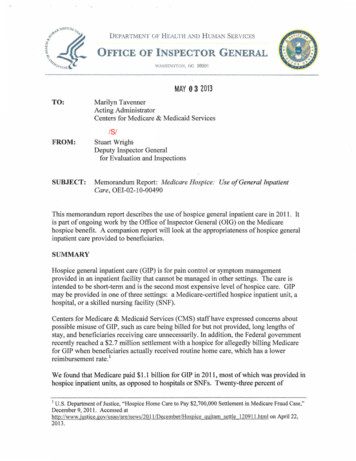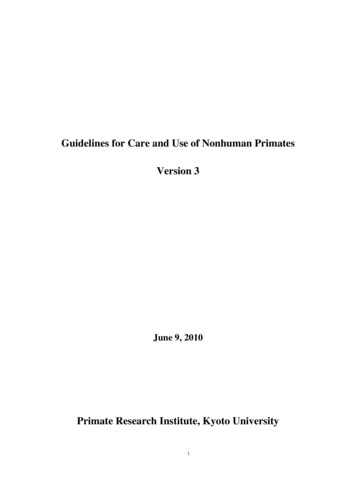
Transcription
Guidelines for Care and Use of Nonhuman PrimatesVersion 3June 9, 2010Primate Research Institute, Kyoto University1
Definitions of termsAccording to the definitions proposed by the Science Council of Japan, the following terms used in the present guidelines are definedbelow.1) Animal experiment: Utilization of animals for education, research, manufacture of biological products or other scientific purposes.2) Facilities: Facilities and equipment used to perform animal experiments.3) Laboratory animals: Animals of mammalian, avian or reptilian species used in animal experiments. In the present guidelines, thisterm in most cases refers to monkeys and thus the term “monkeys” is often used as a synonym for “laboratory animals”.4) Institutions: Organizations (university, institute, independent administrative body, company, etc.) where animal experiments areperformed.5) Director of the institution: A person with overall responsibility in the institution for the proper and safe conduct of animalexperiments (dean, director of an institution, principal of a school, chairperson of the board of directors, president, head of an institute,etc.).6) Animal experiment protocol: A protocol drafted in advance regarding the conduct of an animal experiment.7) Animal experiment researcher: A person(s) performing the animal experiment.8) Principal investigator: A researcher who supervises all duties related to the animal experiment protocol.9) Manager: A person(s) who undertakes the management of laboratory animals and facilities under supervision of the director of theinstitution (head of the animal experimentation facilities, department head, etc.)10) Laboratory animal manager: A laboratory animal manager assists the manager and is in charge of management of the laboratoryanimals.11) Animal caretaker: A person(s) in charge of the care and management of laboratory animals under supervision of the laboratoryanimal manager or animal experiment researcher.12) Manager etc.: Refer to the director of the institution, manager, laboratory animal manager, animal experiment researcher and animalcaretaker.2
13) Regulations: In-house regulations of research institutions specified for the proper conduct of animal experiments and the proper careand management of laboratory animals based on applicable laws/regulations and guidelines.3
Chapter I: Basic ・・・・・・・・71. Responsibility of the director of the institution2. Establishment of Monkey Committee3. Roles of the Center for Human Evolution Modeling Research4. Principles of the use of homebred NHPs5. Restrictions on the use of NHPs species not established as laboratory animals for research purposes6. Care and management of animals from the standpoints of veterinary medicine and animal welfare7. Principles of humane handling and authority of the Monkey Committee8. Training programs and licensing system for PRI personnel involved in the care and use of NHPs9. Health and safety management for PRI personnel involved in the care and use of NHPs and responsibilities of relevant committees10. Principles of information disclosure11. Research activities conducted by PRI personnel outside PRIChapter II: Facility design and �・1. Specified animals and invasive alien species2. Relation of NHPs housing/experiment facilities to other areas3. Components of NHPs housing/experiment facilities and locations of each room4. Building structure and equipment1) Building materials2) Corridors3) Doors to animal housing facilities4) Exterior windows5) Floor6) Drainage system7) Walls8) Ceilings9) Air conditioning10) Ventilation11) Electric power and lighting12) Noise control13) Equipment washing/disinfection facilities14) Facilities for sterile surgical procedures5. Outdoor housing facilities1) Purpose of outdoor housing2) Security considerations3) Structural considerations414
4) Care management and veterinary management5) Behavioral managementChapter III: Rearing ・・・・・211. Cages1) Requirements for cages2) Maintenance of environment taking animal welfare into account (see Chapter V)3) Housing space4) Movement in captivity2. Cage rooms1) Microenvironment and macroenvironment2) Temperature and humidity3) Noise4) Environmental control3. Food and water1) Feeding2) Water supply3) Storage of food, etc.4. Other1) Individual identification and recording2) Management in case of emergency, power outage or holidays3) Cleaning4) Disposal of wasteChapter IV: Veterinary ��・・・1. Preventive medicine1) Precautions for entering/leaving monkey housing facilities and working clothes for handling NHPs2) Introduction of NHPs3) Quarantine and acclimatization4) Separation of animals by species, place of origin and health status2. Disease monitoring and control3. Surgical procedures and postoperative management4. Anesthesia and analgesia5. Euthanasia1) When euthanasia is considered acceptable2) Methods of euthanasia533
3) Principles in conducting experimental sacrifice, sample collection and reporting of the completion of euthanasia6. Disposal of carcasses1) Euthanasia2) Animals that died from causes other than euthanasiaChapter V: Considerations of the behavior and psychological condition of NHPs・・・431. Considerations of the behavior and psychological condition2. Environmental enrichment1) Physical environment2) Introduction of novelty, unconstantness, selectability and controllability3) Social environment4) Improvement of the relationship of animals with animal experimental researchers and animal caretakers5) Reduction of physical pain and stress.3. Implementation and evaluation of environmental enrichment4. Research and animal welfareChapter VI: Planning and conducting of animal experiments・・・・・・・・・461. Submission and approval of the animal experiment protocol2. Categories of experiments3. Health management during animal experiments4. Conduct of animal experiments involving restrictions1) Experiments involving restrictions2) Conduct of experiments involving restrictions and recording3) Water restrictions4) Feeding restrictions5) Evaluation of the effects of restrictions and actions to be taken5. Blood sampling and biopsy6. Animal experiments using hazardous substances7. Animal experiments using recombinant DNA8. Euthanasia notification and reporting/verification of completion of �・・AppendixApplicable laws and regulations (Japanese only)659
Chapter I: Basic policiesResearch and education activities using animals in life science, medicine and veterinary medicine are conducted for the promotion of humanhealth/well-being or the protection or improvement of the welfare of wild and captive animals. Animal experiments/studies are indispensable forpromoting these research/education activities and advances in science. These animal experiments should be managed and conducted voluntarilyunder the responsibility of each research institution. Through such ethical management, Japanese life science and medical and veterinaryresearch activities have been developed in a free and creative manner and have contributed to impressive developments across the world. For theproper conduct of ethical management, the care, management and use of laboratory animals for research and education purposes should beperformed properly based on scientific and specialized knowledge and a full understanding of the characteristics of each animal species. Inaddition, the animal experiment protocol should be prepared based not only on scientific reasonability but also on sufficient humanitarian/ethicalconsiderations for laboratory animals.Research activities must be conducted in compliance with the internationally accepted 3R principles of animal experimentation, which wereincluded in the Act on Welfare and Management of Animals amended in 2005 (effective since June 1, 2006). The “3Rs” refer to replacement(use of alternative methods; i.e. non-animal research methods or substituting animals), reduction (use of fewer animals while maintainingscientific reliability) and refinement (refining experimenter’s technique and knowledge to minimize pain and distress experienced by laboratoryanimals). Moreover, consideration must be given to the four Rs, which additionally includes the responsibility of researchers. Nonhumanprimates (NHPs) are more closely related to humans than other animal species and have highly social lives and advanced mental function.Therefore, research activities using NHPs must be conducted based on sufficient consideration of the significance of using NHPs and it must beensured that the research objectives can only be achieved with NHPs. This document describes basic knowledge and regulations required forconducting such research activities.This document was prepared based on the provisions of the Guidelines for Proper Conduct of Animal Experiments (June 1, 2006; ScienceCouncil of Japan), Basic Policies for the Conduct of Animal Experiments in Research Institutions under the Jurisdiction of the Ministry ofHealth, Labor and Welfare (effective on June 1, 2006; Ministry of Health, Labor and Welfare (MHLW)), Fundamental Guidelines for ProperConduct of Animal Experiment and Related Activities in Academic Research Institutions (Notice No. 71 of the Ministry of Education, Culture,Sports, Science and Technology (MEXT) dated June 1, 2006) and Standards Relating to the Care and Management of Laboratory Animals andRelief of Pain (Notice No. 88 of the Ministry of the Environment dated April 28, 2006).This document does not simply describe minimal requirement, but also actively provides abstract guidelines that would help in identifyingobjectives to be achieved and resolving current problems through ceaseless efforts. These guidelines primarily concern the NHPs that arehoused and used in research activities in the Primate Research Institute of Kyoto University (hereinafter, referred to as “PRI”). For otherlaboratory animals, special instructions only are presented in this document.This chapter describes the basic policy for the care and use of laboratory animals at PRI.1. Responsibility of the director of the institutionThe president of Kyoto University (hereinafter, referred to as “the President”) bears the final responsibility for all animal experiments andrelated activities conducted in Kyoto University. The President organizes PRI as an institution required for the proper care and management oflaboratory NHPs and proper and safe conduct of animal experiments and related activities, and appoints the director of PRI (hereinafter,7
referred to as “the Director”) as the manager of the institution. The President delegates all responsibilities for animal experiments conducted inPRI to the Director and the Director assumes the responsibilities on behalf of the President.The Director performs all administrative duties concerning the care, management, breeding and supply of NHPs kept in PRI. The Presidentmay also appoint, based on the Director’s recommendation, a person with knowledge and expertise related to laboratory animals as the head ofthe Center for Human Evolution Modeling Research (hereinafter, referred to as “the Head of CHEMR) as the laboratory animal manager andallow the director of CHEMR to perform the duties of the Director of PRI on his/her behalf. The Director of PRI must also establish, based onrelevant policies, regulations including the authority and responsibilities of the Director of the institution, procedures for the conduct of animalexperiments, proper care and management of laboratory animals and methods of maintenance and management of facilities.2. Establishment of Monkey CommitteeFor the effective execution of the basic policy for the care and use of NHPs (i.e. the guidelines described in this document), the “AnimalWelfare and Animal Care Committee ( Monkey Committee)” shall be established as the organization to prepare animal care/managementpolicies, assess the validity of the animal experiment protocol and supervise the conduct of the protocol.The Monkey Committee is composed of:- one or more council member(s) from each department and- one or more council member(s) from CHEMR who are qualified veterinarians.The Committee shall also be attended by the Head (or designee) of CHEMR and one of its technical staff. One of the administrative staffmembers of the Research Aid Division shall also attend the Committee to prepare meeting minutes and retain related documents, such as theanimal experiment protocol. In case of problems that cannot be managed by these members only, the attendance of additional temporarymembers may be requested upon consultation with council members. For the ethical review of an animal experiment protocol, one or moreoutside monkey expert(s) and one or more non-research personnel shall be included in the Committee.The Director of PRI consults with the Monkey Committee regarding whether the submitted animal experiment protocol complies with theguidelines specified in this document and related regulations, and approves the protocol if judged appropriate based on the review results of theMonkey Committee or issues necessary instructions/advice if the protocol is judged inadequate. The Director also gives necessaryinstructions/advice based on the results of the Monkey Committee inspection of the status of animal care and experiments. Laboratory animalsother than NHPs should be handled in the same manner. The Monkey Committee shall be convened periodically or when deemed necessary bythe Director of PRI or the Chair of the Monkey Committee, to discuss the items listed below. The Monkey Committee also conducts periodicinspections and implements necessary measures, such as recommendations for improvement, when deemed necessary. The procedures forconducting animal experiments are described in Chapter IV.Inspection and assessment of animal care facilities and care conditionsFaculty staff members who are qualified veterinarians periodically conduct the inspection and assessment of animal care facilities and careconditions. Inspection/assessment results shall be reported by the person in charge of inspection/assessment to the Chair of the MonkeyCommittee. The Chair of the Monkey Committee shall convene the Committee to review the inspection/assessment results and report to theDirector of PRI when deemed necessary. The Director provides the animal care staff with instructions/advice when deemed necessary.Review of validity of the animal experiment protocol for educational and research purposes and advice thereonFollowing the guidelines specified in this document, the Monkey Committee conducts ethical review of the animal experiment protocol8
submitted by a researcher and report the review results to the Director of PRI. The Director approves the protocol if judged appropriate basedon the review results or gives necessary instructions/advice if the protocol is judged inadequate.Allocation of NHPs to researchers and arrangements for the care and use of NHPs in PRIWith cooperation of the faculty members of CHEMR, the Monkey Committee determines the number of NHPs to be allocated to eachresearcher and where to keep them, taking into consideration the species and number of NHPs requested for each experiment.Assessment of current status of animal experiments and issuance of recommendations for improvement or orders to discontinue theexperiment through the Director of PRI when deemed necessaryFaculty staff members who are qualified veterinarians periodically conduct the inspection and assessment of laboratories and the status ofthe experiment. Inspection/assessment results shall be reported by the person in charge of the inspection/assessment to the Chair of theMonkey Committee. The Chair of the Monkey Committee shall convene the Committee to review the inspection/assessment results and reportto the Director of PRI when deemed necessary. The Director issues instructions, advice and recommendations to the animal experimentresearcher and may order the discontinuation of the experiment if no improvement is seen.Assessment of animal experiment reportsThe Monkey Committee reviews the conduct of the experiment based on the Animal Experiment Completion Report submitted at the end ofthe study and reports the evaluation results to the Director of PRI. Based on the evaluation, the Director may issue instructions/advice to theanimal experiment researcher when deemed necessary.Planning and adjustment of the breeding and introduction of NHPs and proposal to CHEMRIn view of future research and educational activities to be performed at PRI, the Monkey Committee selects the species of NHPs to bebred/reared and prepares and reviews an introduction schedule.Safety measures for the handling of NHPs and management of the working environmentThe Monkey Committee shall implement safety measures for the handling of NHPs and maintenance of the working environment incooperation with Inuyama Health Committee.Other activities to be performed as required by Kyoto University, PRI or relevant laws and regulations3. Roles of the Center for Human Evolution Modeling ResearchThe administrative duties related to the care, management, breeding and supply of NHPs should basically be performed by faculty membersat CHEMR (i.e. animal caretakers) in an integrated manner under the supervision of the Director of CHEMR. CHEMR shall seek to provide awide range of services, such as clinical veterinary, disease control, animal welfare and research support services. CHEMR shall also cooperatewith the Monkey Committee to ensure that laboratory NHPs are kept in a healthy state and properly used for experiments.The specific duties of CHEMR include the following.1) All types of duties relating to the care, breeding, management and supply of NHPs.2) Maintenance of established model NHPs.3) Maintenance of facilities and equipment.4) Training program provision for animal experiment researchers and animal caretakers under instruction from the Monkey Committee andfamiliarizing them with relevant laws and guidelines.5) Planning and arrangement of the breeding/introduction of NHPs under instruction from the Monkey Committee.9
6) Hazard prevention and health management measures, including maintenance of environment and prevention of disease, at PRI incooperation with the Monkey Committee, Inuyama Health Committee and other related committees.7) Improving personnel’s awareness of safety management in cooperation with the Monkey Committee, Inuyama Health Committee andother related committees.8) Other duties required for the smooth management of CHEMR.4. Principles of the use of homebred NHPsBasically, only systematically bred NHPs shall be used for experiments. Wild NHPs, even if they are derived from harmful wildlife control,shall not be accepted in principle to prevent unnecessary wildlife control. When the introduction of wild NHPs is required for particularresearch purposes, the use of wild NHPs shall be described in the animal experiment protocol and reviewed by the Monkey Committee inaccordance with the guidelines established by the Field Research Committee (“Guidelines for Studying Wild Primates or Using Wild Primatesin Research”). The replacement of animals or introduction of foreign species should be carefully considered in view of the abundance andbreeding status of the relevant species, not to mention in compliance with regulations concerning the import/export of animals, such as theConvention on International Trade in Endangered Species of Wild Fauna and Flora (CITES) and the Law for the Conservation of EndangeredSpecies of Wild Fauna and Flora (Ministry of the Environment, effective in April 1993). The purchase of species established as laboratoryanimals (i.e. those with an established breeding/supply system) and use of them for education/research purposes shall also be reviewed by theMonkey Committee. The Monkey Committee contacts the Director of CHEMR to determine whether the relevant species can be introducedinto the Center.5. Restrictions on the use of NHPs species not established as laboratory animals for research purposesThe protocol for a research project using NHPs species not established as laboratory animals (i.e. those with no established breeding/supplysystem and which cannot be continuously supplied without introducing wild animals) shall be reviewed by the Monkey Committee inaccordance with the principles described below. The Committee reports the review results to the Director of PRI. The Director approves ordoes not approve the protocol based on the Committee’s review results.The principles are as follows.i. Research projects involving experimental sacrifice of animals, including euthanasia, or those that cause animals to have irreversible loss ofphysical functions required for normal living activities, including social activities, are acceptable only if deemed absolutely necessary.ii. There must be no alternative methods and must be a reasonable, compelling reason for using the relevant species.6. Care and management of animals from the standpoints of veterinary medicine and animal welfareThe care and management of NHPs must be performed based on veterinary knowledge and experience. These management proceduresinclude assessment of whether animal welfare is adequately taken into account such that not only the physical but also behavioral andpsychological conditions of the animals can be maintained in a healthy state. Animal welfare refers to the state of animals being able to copewith the surrounding environment. For evaluating the status of animal welfare, it is essential to have appropriate physiological, psychologicaland behavioral markers, in addition to evaluating the presence or absence of illness, injury or pain. The details of the care/managementprocedures are separately described in Chapters III and IV. Users are required not only to comply with the Act on Welfare and Management of10
Animals and other relevant laws, but also always to conduct themselves with animal welfare in mind.7. Principles of humane handling and authority of the Monkey CommitteeThe conduct of experiments using pathogens or toxic chemicals, causing stress and pain to animals, requiring repeated surgical procedures,involving long-term restraint of animals in a monkey chair or other equipment, involving feeding and/or water restriction or using very younganimals shall be reviewed with extra care by the Monkey Committee and other relevant committees during assessment of the validity of theanimal experiment protocol. Depending on the degree of pain and health status of NHPs, the Monkey Committee may provide the principalinvestigator and animal experimental researchers with instructions and/or advice, such as recommendations for changes to the experimentalschedule and experimental procedures. The details of experimental procedures, including blood sampling and biopsy, are described in ChaptersIV and VI. When it has been determined that NHPs are being handled inappropriately, the Monkey Committee shall immediately request theprincipal investigator to improve the method for handling NHPs. The Committee may report to the Director of PRI when deemed necessary,and if no improvement is seen, the Director may recommend the discontinuation of the experiment or impose such penalties as prohibiting theuse of NHPs.8. Training programs and licensing system for PRI personnel involved in the care and use of NHPsThe care, management and use of NHPs should be performed, in principle, only by PRI personnel. All PRI personnel involved in the careand use of NHPs (i.e. animal experiment researchers and animal caretakers, including permanent or part-time staff, graduate students, researchfellows/trainees/students and collaborating research fellows) are required to complete the animal experiment training programs provided byKyoto University. Because the conduct of experiments using NHPs requires different knowledge and skills depending on the degree of contactwith animals and invasiveness of experimental procedures, those who are conducting these experiments are required to acquire in advance thenecessary knowledge and skills. Those who wish to use NHPs in an experiment shall thus attend lectures and practical training programsprovided by the Monkey Committee and CHEMR to be trained in the proper handling of NHPs and obtain appropriate licenses requiredaccording to the degree of contact with animals and invasiveness of experimental procedures. A written pledge and copies of the results ofchest X-ray examination and measles antibody testing shall also be submitted. Each license has a specific expiration date and must be renewedthrough attendance of lectures/practical training programs when expired . Details are given in Chapter VI.9. Health and safety management for PRI personnel involved in the care and use of NHPs andresponsibilities of relevant committeesMany of the diseases affecting NHPs are also observed in humans (for more details about infectious diseases, see Appendix “InfectiousDiseases in NHPs” and Chapter II of the Safety and Health Manual issued by PRI). The health and safety management for researchers whoperform experiments using NHPs and animal caretakers is important in terms of protection against disease transmission from NHPs. The careand use of NHPs is associated with the risks of bites, scratching and disease transmission from animals (or transmitting disease TO animals) aswell as health hazards and contamination caused by washing/disinfection agents. The Monkey Committee and CHEMR shall implementappropriate measures against these risks in cooperation with Inuyama Health Committee. In the event of accidents associated with these riskfactors, the person involved in the accident or someone who has witnessed the accident shall report to the Monkey Committee, CHEMR andGeneral Affairs Division without delay (see the Safety and Health Manual). The Monkey Committee and CHEMR shall implement necessary11
measures to cope with the accident. Sterilization and disinfection procedures are described in Chapter II.Those who are expected to be involved in research activities using biological (e.g. pathogens), chemical (e.g. toxic chemicals) or physical(e.g. electromagnetic wave, radioactive materials) hazardous materials or equipment must be trained in the handling of hazardous materials andequipment and, if applicable, obtain necessary qualifications. The overall risk associated with a particular animal experiment protocolinvolving NHPs is reviewed by the Monkey Committee while risks associated with individual experimental procedures are reviewed by theDisease Control Committee, Biosafety Committee, Chemical Substance Control Committee, Radiation Safety Committee or Inuyama HealthCommittee, depending on their details. Waste materials arising from animal experiments shall be disposed of in accordance with the guidelinesestablished by Inuyama Health Committee.10. Principles of information disclosureThe documents pertaining to the care, management and use of NHPs for research and education purposes, as listed below, shall be disclosedas required based on the principle of information disclosure, within a range that does not affect personal privacy or research benefits.Conventions and guidelinesGuidelines for the care, management and use of NHPsMonkey Committee relatedMonkey Committee meeting minutesAnimal experiment protocolLaboratory animal use planReport of completion of experiment using primatesEuthanasia reportMonkey Committee review resultsCHEMR relatedCHEMR meeting minutesAnimal care records (e.g. records of the species, number and age of animals used, rearing conditions, dietary components and feedingschedule)Documents related to the use of animals in experiments (e.g. records of the number of animals used and the details of procedures performed)Application for delivery of primates to PRIShared use and collaborative research relatedApplication for Shared Use/Collaborative ResearchShared Use/Collaborative Research ReportIn-house inspection/assessment relatedIn-house inspection/assessment results11. Research activities conducted by PRI personnel outside PRIResearchers whose primary affiliation is with PRI and who wish to conduct a research project using NHPs at another research institutionshall also submit an animal experiment protocol to the Monkey Committee for review and obtain approval from the Director of PRI before12
conducting the research project. If the protocol has passed ethical review at another research institution, a copy of the written approval must besubmitted to the Monkey Committee. The conduct of the research project must be in accordance with the guidelines specified by PRI.13
Chapter II: Facility design and equipmentA laboratory animal facility that is adequately examined during its planning, designing and building and is appropriately maintained is anessential element of the proper management and use of laboratory animals, and facilitates proper facility management in terms of efficiency,economy, safety and animal welfare. The design and scale of a laboratory animal facility is determined according to research area, the speciesand number of animals to be housed, positional relationship with non-animal areas and geographical condition.This chapter describes facility designs and architectural characteristics to be considered when designing and managing animal care facilitiesfor laboratory Nonhuman primates (NHPs) and factors to be considered when repairing existing facilities.1. Specified animals and invasive alien speciesAccording to Article 26 of the Act on Welfare and Management of Animals, specified animals are defined as animals that may harm humanlife, health or property. A Ministry of the Environment ordinance specifies that these animals should be reared and kept based on approval bythe governor of the relevant prefecture fo
(use of alternative methods; i.e. non-animal research methods or substituting animals), reduction (use of fewer animals while maintaining scientific reliability) and refinement (refining experimenter's technique and knowledge to minimize pain and distress experienced by laboratory animals).





